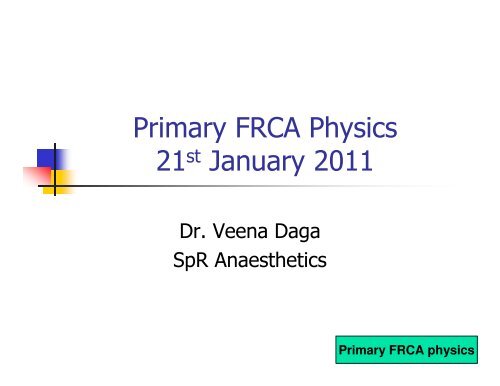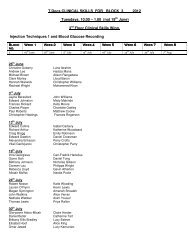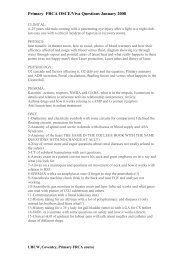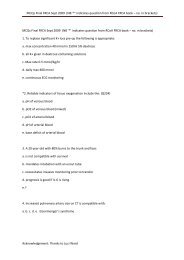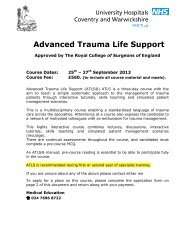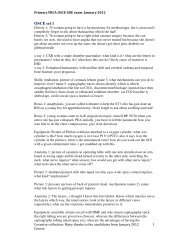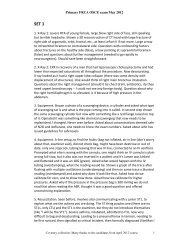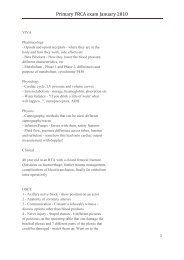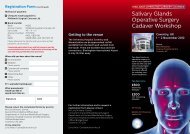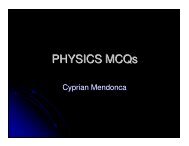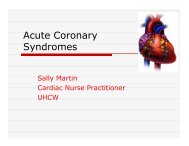Primary FRCA Physics 21st January 2011 - Mededcoventry.com
Primary FRCA Physics 21st January 2011 - Mededcoventry.com
Primary FRCA Physics 21st January 2011 - Mededcoventry.com
You also want an ePaper? Increase the reach of your titles
YUMPU automatically turns print PDFs into web optimized ePapers that Google loves.
<strong>Primary</strong> <strong>FRCA</strong> <strong>Physics</strong>21 st <strong>January</strong> <strong>2011</strong>Dr. Veena DagaSpR Anaesthetics<strong>Primary</strong> <strong>FRCA</strong> physics
1. The following can interferein modern pacemaker. a) T - MRI equipment b) T - Electrosurgical equipment c) T - Physiotherapy equipment d) T - Microwave ovens. e) T - Electric motors.<strong>Primary</strong> <strong>FRCA</strong> physics
3. Defibrillatora) F - mainly used for VF and cardioversion.b) T -It stores electrical charge and thenreleased in a controlled fashion.c) F - two plates separated by an insulator.d) F - depends on the charge, thecapacitance and the potential.e) T -The maximum delivered energy is360J<strong>Primary</strong> <strong>FRCA</strong> physics
4. The nerve stimulatora) T - It can stimulate both motor andsensory nerves.b) F - The negative electrode is activeelectrode and placed over the nerve.c) F - The both electrodes placed fewcentimetres apart.d) T - Peak current is up to 60 mA.e) T - The stimulator gives a very shortelectrical pulse of about 200 us.<strong>Primary</strong> <strong>FRCA</strong> physics
5.Electricitya) F - Electro medical equipment divided into3 class.b) T - Class I equipment contains liveneutral and earth wire.c) T - Class II are double insulatedequipmentd) F - Class III doesn’t needs electricalsupply.e) F - Class II contains only live and neutralwire, double insulated.<strong>Primary</strong> <strong>FRCA</strong> physics
6. Symbols a) F - Impedance is known as ‘Z’ b) T - ‘W’ is a symbol of power. c) F - ‘GHz’ is gigahertz d) T - ‘F’ is a unit of capacitance. e) F - ‘K’ Kelvin is base SI unit oftemperature.<strong>Primary</strong> <strong>FRCA</strong> physics
7.Fuel cella) F - measures Oxygen.b) F - at cathode.c) T - Fuel cell acts as a battery.d) F - lead anode, gold cathodee) T - Fuel cell requires less maintenancethan polarographic electrode.<strong>Primary</strong> <strong>FRCA</strong> physics
8. CO 2 electrode a) T - also known as Severinghaus CO 2electrode. b) F - must maintained at 37 degreetemperature. c) T - measure H + changes. d) F - Sodium bicarbonate as a solution. e) T - it contains hydrogen ion sensitiveglass.<strong>Primary</strong> <strong>FRCA</strong> physics
9. Nitrous oxide measurement a) F - Paramagnetic analysis O 2 b) T - Mass spectrometry. c) F - Severingaus electrode – CO 2 d) T - Infrared analysis. e) F - Ultraviolet analysis - halothane<strong>Primary</strong> <strong>FRCA</strong> physics
10. Transducer.a) T - converts pressure variations into anelecrtrical signal.b) T - converts sound to an electrical signalc) T - converts electrical energy into heatenergy.d) T - converts temperature variations into anelectrical signal.e) F - The capacitor in a DC defibrillator.<strong>Primary</strong> <strong>FRCA</strong> physics
11. Adiabatic change. a) T - Fractional distillation of air. b) T - functioning of Cryoprobe. c) F - Ultrasound. d) F - Poynting effect. e) F - Diathermy.<strong>Primary</strong> <strong>FRCA</strong> physics
12. Gas chromatography a) T - Volatile anaesthetic agents. b) T - Barbiturates c) T - Phénothiazines. d) T - Benzodiazepines. e) F - Muscle relaxantsSteroids and catecholamines can bemeasured by gas chromatography.<strong>Primary</strong> <strong>FRCA</strong> physics
13. Laser - characteristics a) T - Parallel b) F - Specific wavelength c) T - Coherence d) F - Cavitations is phenomenon toultrasound waves e) T - Collimation<strong>Primary</strong> <strong>FRCA</strong> physics
14. Boyle’s Lawa) F - relates pressure to volume.b) F - relates volume to pressure.c) T - relates pressure to volume.d) Fe) T - temperature should be constant.<strong>Primary</strong> <strong>FRCA</strong> physics
15. Flowa) F - the density of the gasb) T - the pressure difference acrossthe tubec) F - barometric pressured) F - ambient pressuree) F - the viscosity of the gas<strong>Primary</strong> <strong>FRCA</strong> physics
Flow Amount of fluid moving per unit time is flow. It may be laminar or turbulent. Laminar flow :WhereQ = Flow in Litres/secondn = ViscosityP = Pressurer = Radius of the tube in metersl = Length of the tube<strong>Primary</strong> <strong>FRCA</strong> physics
16 pulse oximetrya) T - At wavelength of 660 absorbance ofoxyhaemoglobin is less than deoxyhaemoglobin,b) F - In infrared light (940 nm), the absorbance ofoxy-Hb is greater than that of deoxy-Hb.c) T - Isobestic point at 805 nm.d) F - The diodes are switched on and off at highfrequency several hundred times a second.e ) T - Pulse oximeter must be used duringanaesthesia.<strong>Primary</strong> <strong>FRCA</strong> physics
17. Errors in measuring BPa) F - Size of patientb) T - Catheter wall <strong>com</strong>pliancec) T - Blood clotsd) T - Air bubblese) F - Type of machine<strong>Primary</strong> <strong>FRCA</strong> physics
18. Pulse oximeter Readings may be inaccurate in followingcondition A) T - Cardiac arrhythmias B) T - Cold C) T - Circulatory collapse D) T - Carboxyhaemoglobin E) F - COPD<strong>Primary</strong> <strong>FRCA</strong> physics
19. Equations a) T - 1 N = 1 kg m s -2 b) F -1 W = 1 J/s c) F - F ( farad)= C ( Coulomb)/ V(Volt) d) T - 1 Pa = 1 N/m 2 e) T - 1 volt = Watt/Ampere<strong>Primary</strong> <strong>FRCA</strong> physics
20.Law shows relationshipbetween gas and liquida) F - pressure and volume.b) T - Henry’s Law - solubility of a gas inliquid is directly proportional to its partialpressure.c) F - Ideal gas law.d) T - Bunsen coefficient.e) F - the rate of diffusion of a substancedown its concentration gradient is inverselyproportional to the square root of itsmolecular weight.<strong>Primary</strong> <strong>FRCA</strong> physics
21. Characteristic of diathermy a) T -High frequency b) T - Fulguration - high densitydiathermy current to cut tissues. c) F - Cavitations is phenomenon toultrasound waves d) F – Collimation for LASER e) F – Coherence for LASER<strong>Primary</strong> <strong>FRCA</strong> physics
22. Critical temperaturea) F - substance cannot be liquefied however muchpressure is applied.b) F - The temperature above which a material losesits ferromagnetism is known as ‘Curie temperaturec) T - The temperature at which a conductor gainsthe property of superconductivity.d) F - At critical temperature all gas be<strong>com</strong>e idealgas.e) T - At critical temperature gas can be liquefiedunder pressure.<strong>Primary</strong> <strong>FRCA</strong> physics
23. Following are same thinga) T -Isolated patient electrical circuit andfloating circuit- earth free circuit.b) T - class II equipment and doubleinsulated equipment.c) T - Clark electrode and polarographicelectrode.d) F - Monopolar and bipolar diathermye) F - Reactance is one form of impedance<strong>Primary</strong> <strong>FRCA</strong> physics
24. Relative humidity a) T - It is pleasant for theatre staff. b) T - It helps in minimizingaccumulation of static electricity. c) F - Reduce heat loss fromanaesthetised patient. d) T - Decrease risk of explosion offlammable agents. e) F - No need to use warmers.<strong>Primary</strong> <strong>FRCA</strong> physics
25.Chi-squared test a) F - discrete or non-continuouslyvariable data. b) F - can be more than 2 X 2. c) T - It includes a calculation forexpected values. d) T - Measured variables must beindependent. e) F - inappropriate for small samples.<strong>Primary</strong> <strong>FRCA</strong> physics
26. Inverse relationship.a) F - The electrical resistance of a conductorincreases with rising temperature.b) F - Density is not a factor in determining laminarflow.c) F - Pressure changes is in proportion of length inlaminar flow – no inverse relationship.d) T - Volume and pressure in respect of Boyle’s law.e) T - Intensity of light and thickness of its mediumof propagation, Beer Lambert Law.<strong>Primary</strong> <strong>FRCA</strong> physics
27. Following increase withrise in temperature.a) F - Viscosity of a liquid decreases astemperature increase.b) F - Solubility of a gas decreases astemperature increases.c) T - SVP of an inhalational anaestheticagent.d) F - Electrical resistance of a semiconductorwill decrease with increase in temperature.e) T - Resistance of platinum resistancethermometer.<strong>Primary</strong> <strong>FRCA</strong> physics
28.Nitrous oxidea) T - Critical temperature (36.4) is higherthan carbon dioxide (31.o4).b) F - Is obtained from heating ammoniumnitrate.c) T - Is stored in blue cylinder.d) F - Oxygen is measured by paramagneticmethod.e) T - With mixture of other gases can beavailable as gas - Entonox.<strong>Primary</strong> <strong>FRCA</strong> physics
29.Reynolds number a) F - doesn’t have unit. b) T - It is higher in number in case ofturbulent flow <strong>com</strong>pare to laminar flow. c) T - Less than 2000 suggests laminarflow. d) F - It is determined by density andviscosity both. e) T - It is proportional to fluid flowvelocity.<strong>Primary</strong> <strong>FRCA</strong> physics
30.Cardiac output a) T - Measuring oxygen consumption. b) T - TOE. c) T - Doppler ultrasound. d) T - Indocyanine green e) T - Thermodilution.<strong>Primary</strong> <strong>FRCA</strong> physics
Good Luc<strong>Primary</strong> <strong>FRCA</strong> physics


